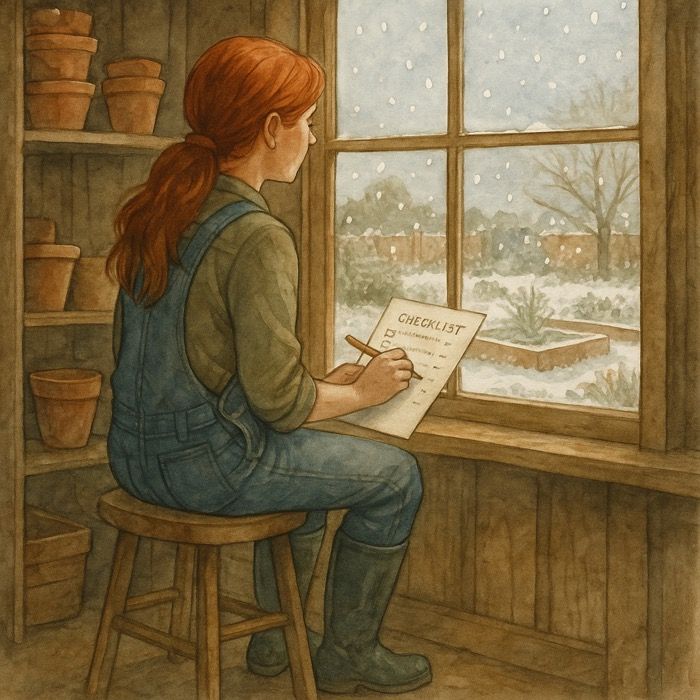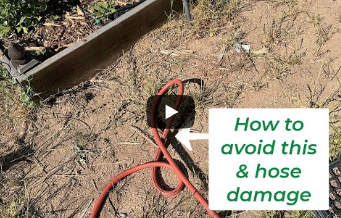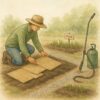The Hidden World of Soil Crusts – What They Are, Why They Kill Seedlings, and How to Fix or Prevent Them
Most gardeners blame pests, nutrient deficiencies, or insufficient sunlight when seedlings fail. But one of the sneakiest—and most overlooked—culprits is a subtle barrier right on the soil surface: soil crusting. If your seeds sprout only to stall, dry out, collapse, or vanish, this hardened layer is likely trapping them. Mastering soil crusts is a game-changing skill that boosts germination rates overnight, builds long-term soil resilience, and turns frustrating failures into reliable success.
What Is a Soil Crust?
A soil crust is a thin (often 1/8–1/4 inch), hardened “skin” that forms on bare soil. It may appear glossy, cracked, or slightly darker than the soil below, but it’s denser than concrete in miniature. This impermeable sheet blocks water infiltration, oxygen diffusion, and seedling emergence. Crusts plague all soil types but strike hardest in disturbed, unprotected beds—think freshly tilled gardens, seed trays, or areas hammered by rain.
Why Soil Crusts Form (The Science in Plain Terms)
Crusts aren’t random; they’re the result of soil aggregates collapsing and fusing. Key triggers:
| Trigger | How It Happens | Real-World Example |
| Heavy rain or overhead sprinklers | Water droplets hit like micro-hammers, shattering aggregates into fines that settle and cement when dry. | A summer thunderstorm on bare beds. |
| Fine dust from decomposing mulch/compost | Tiny particles sift down, then glue together during wet-dry cycles. | Old wood chips breaking into powder. |
| Microbial “glues” | Beneficial fungi and bacteria exude polysaccharides that bind particles—great underground, disastrous on the surface when baked by sun. | Healthy but exposed compost-rich soil. |
| Mechanical compression | Foot traffic, hose dragging, or repeated watering compacts the top layer. | Walking between rows after planting. |
Pro Tip: Clay-rich soils crust fastest; sandy soils resist but still suffer under heavy irrigation.
How Crusts Silently Sabotage Seedlings
The damage is insidious because it mimics other problems:
- Water Repelled → Runs off or beads up; roots stay parched despite frequent watering.
- Oxygen Starved → Germination halts in anaerobic conditions.
- Physical Barrier → Seedlings expend energy pushing against the crust, often bending (“corkscrewing”) or dying trapped below.
- Extreme Temperature Swings → Sealed surface acts like a greenhouse lid—scorching by day, chilling by night.
Visual Cue: If water pools or runs off your bed instead of soaking in within seconds, crusting is active.
Quick Fixes for Existing Crusts (Gentle & Immediate)
No need for deep tillage—just target the top 1/8 inch.
| Method | Steps | Why It Works |
| Light scarification | Use a hand fork, rake, or even a stiff broom to crumble the surface into pea-sized bits. | Reopens pores without destroying structure. |
| Soft rehydration | Mist with a fine rose or wand until moist (not soggy). | Softens crust for easier break-up. |
| Instant mulch layer | Spread 1/4–1/2 inch of sifted compost, leaf mold, or coco coir. | Shields soil while aggregates rebuild. |
| Vermiculite top-dress | Sprinkle 1/8 inch over seeds post-planting. | Stays fluffy, wicks moisture, prevents sealing. |
Success Story: One gardener broke a crust on 50 sq ft of carrot beds with a leaf rake + vermiculite in 10 minutes—germination jumped from 20% to 85% in a week.
Bulletproof Prevention Strategies
Bare soil = crust magnet. Cover and protect from Day 1.
1. Never Leave Soil Naked
- Pre-cover seed beds with sifted compost, leaf mold, coco coir, or vermiculite (1/8–1/4 inch).
- For trays: Use a floating row cover or humidity dome until sprouts emerge.
2. Water Like a Pro
- Bottom-water trays.
- Use soaker hoses, micro-sprinklers, or a wand on shower mode.
- Avoid high-pressure nozzles or overhead cans.
3. Minimize Traffic
- Install permanent paths or boards to walk on.
- Coil hoses at bed edges.
4. Refresh Mulch Before It Turns to Dust
- Rake and replace decomposing mulch in late winter.
- Top-dress with coarse material (straw, shredded bark) to filter fines.
5. Boost Biological Armor
- Add compost tea or mycorrhizal inoculants to encourage fungal networks that stabilize without surface sealing.
- Keep soil covered year-round to feed microbes continuously.
Visual Diagnostic Checklist (Print & Pin in Your Shed)
| Symptom | Likely Crust? | Quick Test |
| Water beads/runs off | Yes | Press finger into soil—hard? |
| Patchy germination | Yes | Lift crust—seedlings trapped below? |
| Seedlings bent or spiraled | Yes | Check for “helmet head” (seed coat stuck). |
| Soil surface glossy/cracked | Yes | Scratch with fingernail—breaks like thin ice? |
Why Mastering Crusts Levels Up Your Gardening Game
Once you see crusts, you can’t unsee them: in struggling trays, direct-sown rows with bald spots, or pots where water sits on top. The fix is dirt-cheap (pun intended) and instant. More importantly: higher yields from better stands, less water waste as infiltration improves, and stronger soil structure that resists erosion and compaction long-term.
Bottom line: Treat the soil surface like the delicate threshold it is—protect it, and your garden will reward you with robust, resilient growth from the very first sprout.
Microgreen Hacks: 3 Crust-Busting Tips for Dense Trays
- Pre-soak + sieve: Soak seeds 4–8 hours, then rinse and spread on a 1/8-inch layer of damp vermiculite. Top with another ultra-thin vermiculite veil—zero crust, 100% emergence for peas, radish, or sunflower.
- Humidity dome shuffle: Cover trays with a clear lid for the first 48–72 hours. Crack it daily for 5 minutes to vent; condensation keeps the surface soft without compaction. Remove once 50% sprouted.
- Bottom-water wick: Place trays in a shallow reservoir with 1/4 inch water + capillary mat. Seeds pull moisture upward, staying fluffy—no overhead droplets to hammer fines into a seal. Perfect for broccoli or kale micros in 10×20 flats.
Bonus: DIY Anti-Crust Seed-Starting Mix
3 parts sifted compost
2 parts coco coir or peat
1 part vermiculite/perlite→ Stays airy, drains perfectly, never crusts. Use for trays or top-dressing direct-sown beds.
More From Our Master Gardener
Recent Posts

The Hidden World of Soil Crusts – What They Are, Why They Kill Seedlings, and How to Fix or Prevent Them

Last-Minute Winter Garden Checklist: 5 Quick Tasks for Gardeners Who Are Behind (Like Me!)

❄️ Snow as Fertilizer – The Truth About “Poor Man’s Nitrogen”

5 Unexpected Winter Weed Control Strategies (That Don’t Involve Mulch)

Harnessing Winter Sun – Passive Solar Tricks for Your Garden















